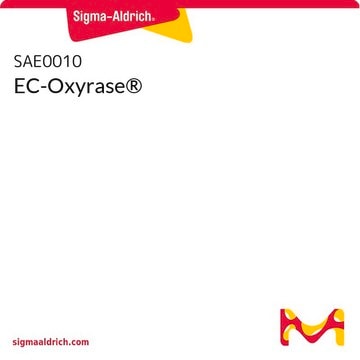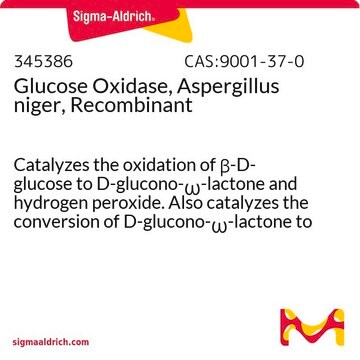P8279
Protocatechuate 3,4-Dioxygenase from Pseudomonas sp.
lyophilized powder, ≥3 units/mg solid
Zaloguj sięWyświetlanie cen organizacyjnych i kontraktowych
About This Item
Numer CAS:
Numer MDL:
Kod UNSPSC:
12352204
NACRES:
NA.54
Polecane produkty
pochodzenie biologiczne
bacterial (Pseudomonas spp.)
Postać
lyophilized powder
aktywność właściwa
≥3 units/mg solid
masa cząsteczkowa
~700 kDa
Warunki transportu
dry ice
temp. przechowywania
−20°C
Opis ogólny
Protocatechuate 3,4-Dioxygenase belongs to the non-heme iron family of enzymes. The active site of the enzyme contains Fe3+.
Zastosowanie
Protocatechuate 3,4-Dioxygenase(PCD), from Pseudomonas sp., is used for the enzymatic determination of choline esterase when coupled with phydroxybenzoate hydroxylase. It is used to improve organic fluorophore-stability in single-molecule experiments and is used to study the metabolism of protocatechuate in Rhizobiaceae.
The enzyme has been used to create an oxygen scavenging system along with protocatechuate (PCA) and Trolox. The enzyme employs a nonheme iron center that catalyzes the conversion of PCA and molecular oxygen into β-carboxy-cis,cis-muconic acid, while the antioxidant Trolox suppresses slow blinking and photobleaching of cyanine dyes. It has been used in the preparation of imaging buffer along with DMB-BSA (dynein motility buffer-BSA), ATP and protocatechuate in single molecule motility assay.
Działania biochem./fizjol.
Protocatechuate 3,4-Dioxygenase catalyzes the degradation of 3,4-dihydroxybenzoate (protocatechuate) into β-carboxy-cis,cis-muconate.
Właściwości fizyczne
Structure : Protein with nonheme iron
Inhibitors : Ag+, Hg++, PCMB
Optimum pH : 9.0
Optimum temperature : 60−65°C
pH Stability : pH 7.0−9.0 (25°C, 72hr)
Thermal stability : below 50°C (pH 6.0, 1hr)
Inhibitors : Ag+, Hg++, PCMB
Optimum pH : 9.0
Optimum temperature : 60−65°C
pH Stability : pH 7.0−9.0 (25°C, 72hr)
Thermal stability : below 50°C (pH 6.0, 1hr)
Definicja jednostki
One unit will oxidize 1.0 μmole of protocatechuate to 3-carboxy-cis,cis-muconate per min at pH 7.5 at 37 °C.
Postać fizyczna
Supplied as lyophilized powder.
Komentarz do analizy
Protein determined by biuret.
inhibitor
Numer produktu
Opis
Cennik
Kod klasy składowania
11 - Combustible Solids
Klasa zagrożenia wodnego (WGK)
WGK 3
Temperatura zapłonu (°F)
Not applicable
Temperatura zapłonu (°C)
Not applicable
Środki ochrony indywidualnej
Eyeshields, Gloves, type N95 (US)
Certyfikaty analizy (CoA)
Poszukaj Certyfikaty analizy (CoA), wpisując numer partii/serii produktów. Numery serii i partii można znaleźć na etykiecie produktu po słowach „seria” lub „partia”.
Masz już ten produkt?
Dokumenty związane z niedawno zakupionymi produktami zostały zamieszczone w Bibliotece dokumentów.
Klienci oglądali również te produkty
Colin Echeverría Aitken et al.
Biophysical journal, 94(5), 1826-1835 (2007-10-09)
The application of single-molecule fluorescence techniques to complex biological systems places demands on the performance of single fluorophores. We present an enzymatic oxygen scavenging system for improved dye stability in single-molecule experiments. We compared the previously described protocatechuic acid/protocatechuate-3,4-dioxygenase system
G Trautwein et al.
Journal of bacteriology, 183(3), 873-881 (2001-02-24)
Protocatechuate degradation is accomplished in a multistep inducible catabolic pathway in Acinetobacter sp. strain ADP1. The induction is brought about by the transcriptional regulator PcaU in concert with the inducer protocatechuate. PcaU, a member of the new IclR family of
G K Podila et al.
Applied and environmental microbiology, 59(8), 2717-2719 (1993-08-01)
A heterologous gene probe encoding the alpha and beta subunits of the Pseudomonas cepacia protocatechuate 3,4-dioxygenase (PCD) was used to detect its homolog in the genome of Bradyrhizobium japonicum USDA110. Three cosmid clones carrying a 2.2-kb BamHI insert showed high
M Contzen et al.
Molecular microbiology, 41(1), 199-205 (2001-07-17)
The genes for a protocatechuate 3,4-dioxygenase (P34O-II) with the ability to oxidize 4-sulphocatechol were cloned from the 4-aminobenzenesulphonate(sulphanilate)-degrading bacterium Hydrogenophaga intermedia strain S1 (DSMZ 5680). Sequence comparisons of the deduced amino acid sequences of both subunits of the P34O-II from
Nicole Michelotti et al.
Methods in enzymology, 475, 121-148 (2010-07-16)
Recent improvements in methods of single-particle fluorescence tracking have permitted detailed studies of molecular motion on the nanometer scale. In a quest to introduce these tools to the burgeoning field of DNA nanotechnology, we have exploited fluorescence imaging with one-nanometer
Nasz zespół naukowców ma doświadczenie we wszystkich obszarach badań, w tym w naukach przyrodniczych, materiałoznawstwie, syntezie chemicznej, chromatografii, analityce i wielu innych dziedzinach.
Skontaktuj się z zespołem ds. pomocy technicznej











